We arrive in Cairns in north Queensland and back in the tropics once again. Snakes, spiders, salties, stingers and rain. All of these deadly dangerous things can kill, even by boredom, and it would be only a matter of time before one of them got us. Australia has half of the most venomous snakes in the world (3 of them live in Queensland), loads of venomous spiders (some of which like to live in shoes overnight), more saltwater crocodiles than you can shake a stick at, box jellyfish and other marine stingers that are actually more poisonous than snakes, even a stinging tree that has a barb that will continue to sting for months after embedding in the skin, and rain that will try to drown you. It will be a miracle if we survive.
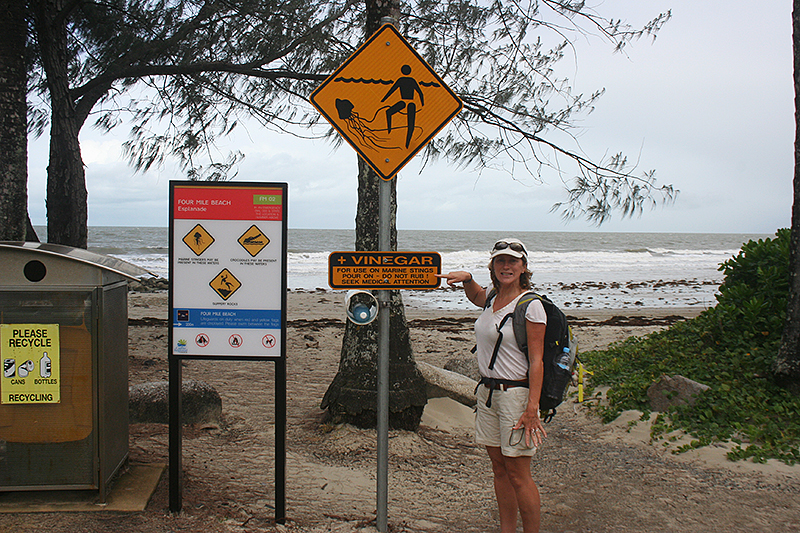 I cannot help but to look forward to coming here because of all the activities that are on offer. You name it, they’ve got it. So it will not come as a surprise that we were deeply disappointed, gutted as the Sun Newspaper would say, to find that the beaches were closed. It is the season of the box jellyfish, a deadly poisonous jellyfish that floats about in the currents up to 300 metres offshore. Get stung by one of these fellas and you learn what pain is. In addition, as it is the wet season, there are loads of male saltwater crocodiles swimming in the sea as they migrate from one river to another looking for females with whom to have sex. Get caught by one of these fellas and you learn what fear is. So all the beaches are shut to water activity and the lifeguards have gone to town to drink beer, judge wet T-shirt competitions and take part in the wet jockstrap shows. Being the wet season, it rained for at least a part of every day so we could not even lie on the beach.
I cannot help but to look forward to coming here because of all the activities that are on offer. You name it, they’ve got it. So it will not come as a surprise that we were deeply disappointed, gutted as the Sun Newspaper would say, to find that the beaches were closed. It is the season of the box jellyfish, a deadly poisonous jellyfish that floats about in the currents up to 300 metres offshore. Get stung by one of these fellas and you learn what pain is. In addition, as it is the wet season, there are loads of male saltwater crocodiles swimming in the sea as they migrate from one river to another looking for females with whom to have sex. Get caught by one of these fellas and you learn what fear is. So all the beaches are shut to water activity and the lifeguards have gone to town to drink beer, judge wet T-shirt competitions and take part in the wet jockstrap shows. Being the wet season, it rained for at least a part of every day so we could not even lie on the beach.
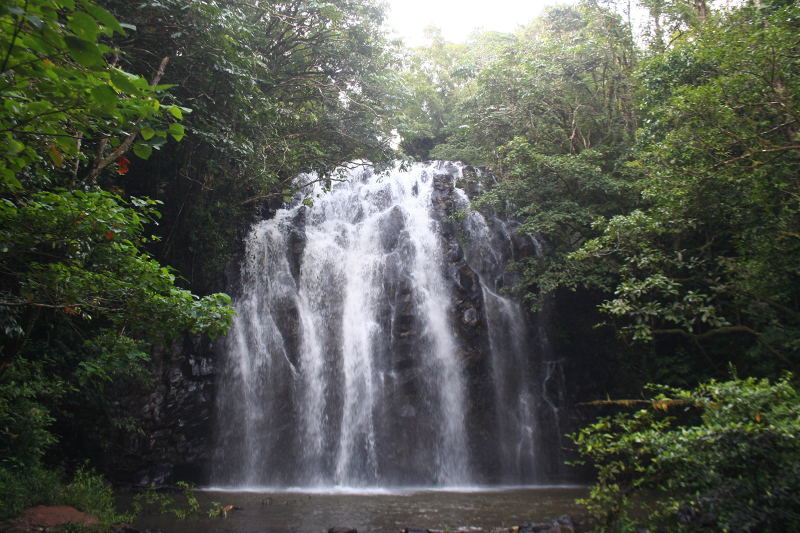 Being British and experienced explorers, a bit of torrential rain was not going to hold us back, so we took to our hire car and went off to investigate the region called Atherton Tablelands. The northern point starts with the Kuranda Rainforest and passes south to to Highway 1 going west into the outback. Being at the upper end of the Great Dividing Range, there are lakes & many waterfalls in full splendour shoving and spilling great gallons of water over picturesque falls into beautiful pools at their base before the streams continue their rush to the sea. The most breathtaking of these are the Millaa Millaa falls. Those of a certain age will remember this fall as being the backdrop to the Timotei shampoo adverts in the 70s, the one where some gorgeous girl in a bikini tilts her head heavenwards to let the cool water wash through her long black hair. I suggested to Debbie that she might like to re-create the ad while I stood at the other end of the pool and, David Bailey-like, snap away copiously. The suggestion did not meet with enthusiasm from my would-be water nymph who felt that, as it was raining, I would get the camera wet. In addition, I would be required to clear the pool below the waterfall of snakes and crocodiles and the surrounding area of people who may infringe her image rights with their own cameras. After a further short discussion, I decided to withdraw my suggestion unreservedly and we continued on to other magnificent but less spectacular falls nearby (Zillie and Ellinjaa Falls).
Being British and experienced explorers, a bit of torrential rain was not going to hold us back, so we took to our hire car and went off to investigate the region called Atherton Tablelands. The northern point starts with the Kuranda Rainforest and passes south to to Highway 1 going west into the outback. Being at the upper end of the Great Dividing Range, there are lakes & many waterfalls in full splendour shoving and spilling great gallons of water over picturesque falls into beautiful pools at their base before the streams continue their rush to the sea. The most breathtaking of these are the Millaa Millaa falls. Those of a certain age will remember this fall as being the backdrop to the Timotei shampoo adverts in the 70s, the one where some gorgeous girl in a bikini tilts her head heavenwards to let the cool water wash through her long black hair. I suggested to Debbie that she might like to re-create the ad while I stood at the other end of the pool and, David Bailey-like, snap away copiously. The suggestion did not meet with enthusiasm from my would-be water nymph who felt that, as it was raining, I would get the camera wet. In addition, I would be required to clear the pool below the waterfall of snakes and crocodiles and the surrounding area of people who may infringe her image rights with their own cameras. After a further short discussion, I decided to withdraw my suggestion unreservedly and we continued on to other magnificent but less spectacular falls nearby (Zillie and Ellinjaa Falls).
The drive up the Dividing Range is steep, twisty and full of switchbacks that are definitely not a road for those who suffer motion sickness. The daft thing is that driving on the coastal plain along a dual, or triple, carriageway, the speed limit is 80kmph and regularly patrolled by the police. The mountain road which is narrow and full of tight corners has a speed limit of 100kmph and the police are noticeable by their absence. I suppose police patrols are not necessary because anyone stupid enough to drive more than 50kmph will end up off the side of the road, down a deep ravine and dead. In which case only an ambulance is required.
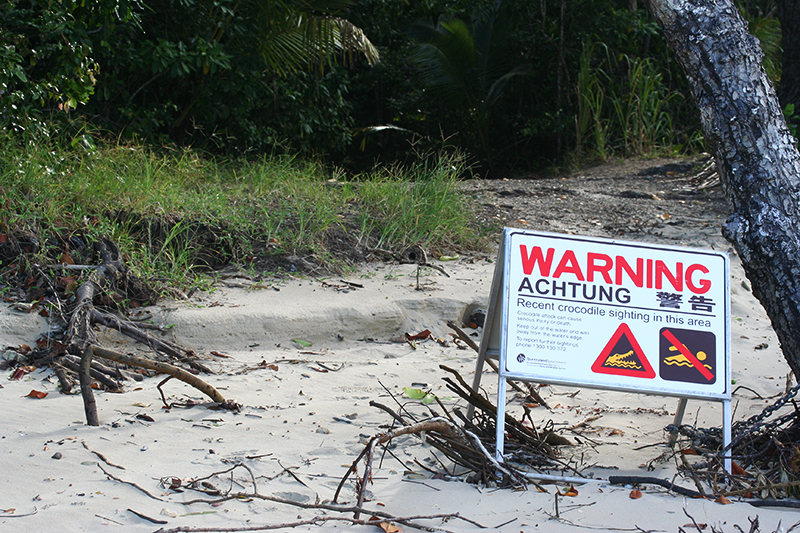 The coast road is much more laid back, winding its way past honey coloured beaches that were deserted (mostly because it was raining). Even in the poor weather there was an urgent feeling to peel off clothes and run from the palm and mango treed border and plunge into the warm, soft waves of the tropical Coral Sea. We wandered along many of the beaches, over fresh water rivers and streams that the rains had created, looking all around us for large reptilians creeping up on us. A discussion ensued as to what action should be taken when faced by a hungry crocodile.
The coast road is much more laid back, winding its way past honey coloured beaches that were deserted (mostly because it was raining). Even in the poor weather there was an urgent feeling to peel off clothes and run from the palm and mango treed border and plunge into the warm, soft waves of the tropical Coral Sea. We wandered along many of the beaches, over fresh water rivers and streams that the rains had created, looking all around us for large reptilians creeping up on us. A discussion ensued as to what action should be taken when faced by a hungry crocodile.
‘I feel perfectly safe with you, Darling,’ I said.
‘Why? I can’t protect you from a big croc.’ replied the Gorgeous One.
‘But I only have to be able to run faster than you.’ I pointed out.
Not very gallant but true nonetheless. Apparently, the beasts can run at quite a pace over a short distance but, as neither of us wanted to take a chance, we walked midway between the sea and the tree line so as to have the maximum start on any hungry croc. We eventually decided that the rocky outcrops were the safest place because ‘Salties can’t climb rocks. Can they?’
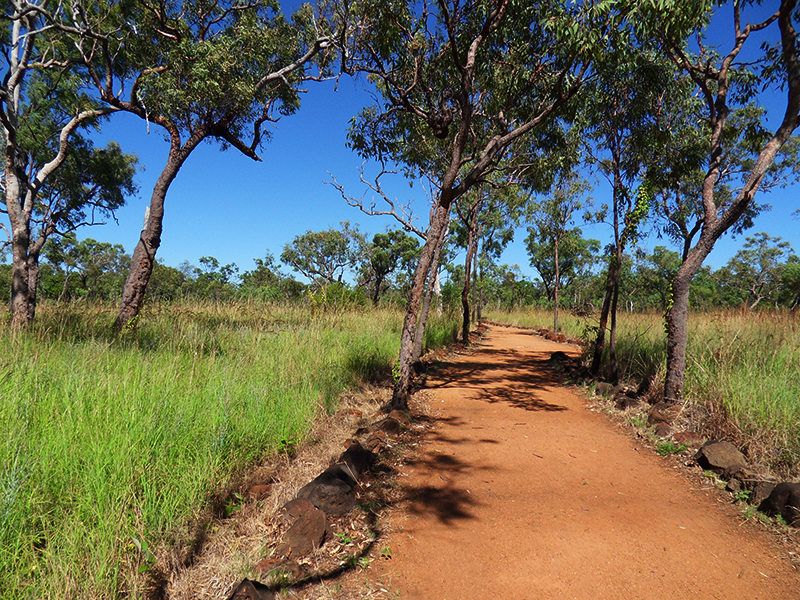 We decided to head for Undara, part of the good old Australian bush, 300 km to the south and on the other side of the mountains. The rain seemed to follow us as we drove up the steep roads of the Great Dividing Range where the trees clung to the slopes and the water washed rivers of red dirt across our path. At the top, the comparative flat lands of the savannah sat amongst the cloud and we passed great cattle ranches where the animals stood drenched and miserable. Eventually, the landscape altered. Long straight roads stretched into the distance, the green grass faded and then disappeared, giving way to scrub and low wiry trees. The rain stopped and the sky cleared as we entered an area where rainfall became a premium, prized commodity and the land was dry and dusty. This relatively short journey had taken us from an area where the average rainfall was 4m per year to an area where it averages 250cm and is sunny for 300 days.
We decided to head for Undara, part of the good old Australian bush, 300 km to the south and on the other side of the mountains. The rain seemed to follow us as we drove up the steep roads of the Great Dividing Range where the trees clung to the slopes and the water washed rivers of red dirt across our path. At the top, the comparative flat lands of the savannah sat amongst the cloud and we passed great cattle ranches where the animals stood drenched and miserable. Eventually, the landscape altered. Long straight roads stretched into the distance, the green grass faded and then disappeared, giving way to scrub and low wiry trees. The rain stopped and the sky cleared as we entered an area where rainfall became a premium, prized commodity and the land was dry and dusty. This relatively short journey had taken us from an area where the average rainfall was 4m per year to an area where it averages 250cm and is sunny for 300 days.
The place where we stayed had converted old railway carriages into bedrooms. Most of the carriages had done 70 years on the tracks before being ‘retired’, rescued and turned into the most unusual accommodation. Our room consisted of half an entire carriage, just big enough for a standard double bed with an old leather bench seat at the end. The bathroom had a toilet, a shower and a pull-down metal wash basin and the whole shiny, wooden structure creaked and groaned with every movement. The manager, a large very cheerful chap generously gave us a 50% discount and the more friendly and chatty we were, the more generous he became with drinks and food. So I can’t recommend this place highly enough! There was a slim chance that his generosity may have had something to do with Debbie letting slip that I was a travel writer and, we resolved as we staggered off to bed, to try that line more often.
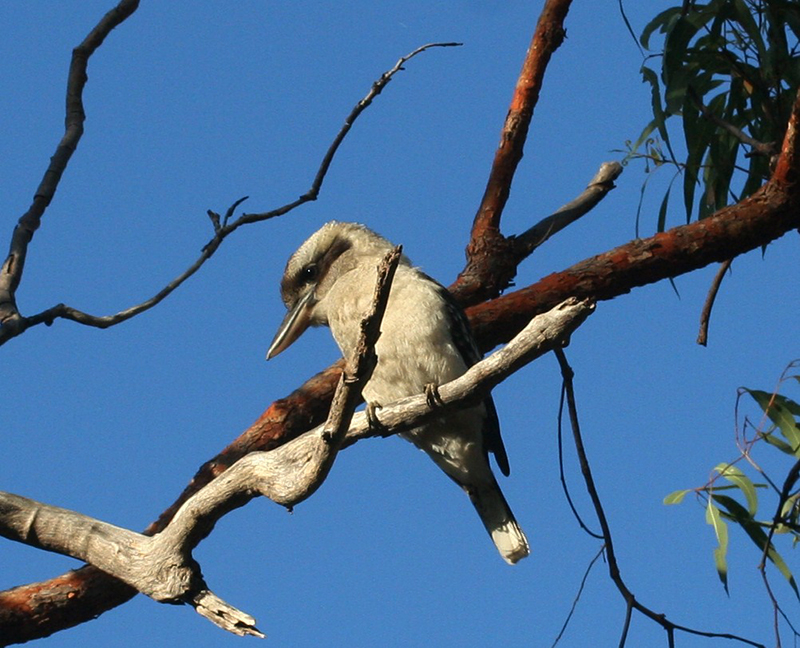 The next morning, we were rudely awoken by a high decibel noise as if a troop of monkeys was holding a disorganized debate. Even through the haze of half sleep we realized that there are no monkeys in Australia and, as I opened the door to yell at them to SHUT UP, a mere 4 kookaburras flew off. What a racket they make: it’s worse than having children in the house.
The next morning, we were rudely awoken by a high decibel noise as if a troop of monkeys was holding a disorganized debate. Even through the haze of half sleep we realized that there are no monkeys in Australia and, as I opened the door to yell at them to SHUT UP, a mere 4 kookaburras flew off. What a racket they make: it’s worse than having children in the house.
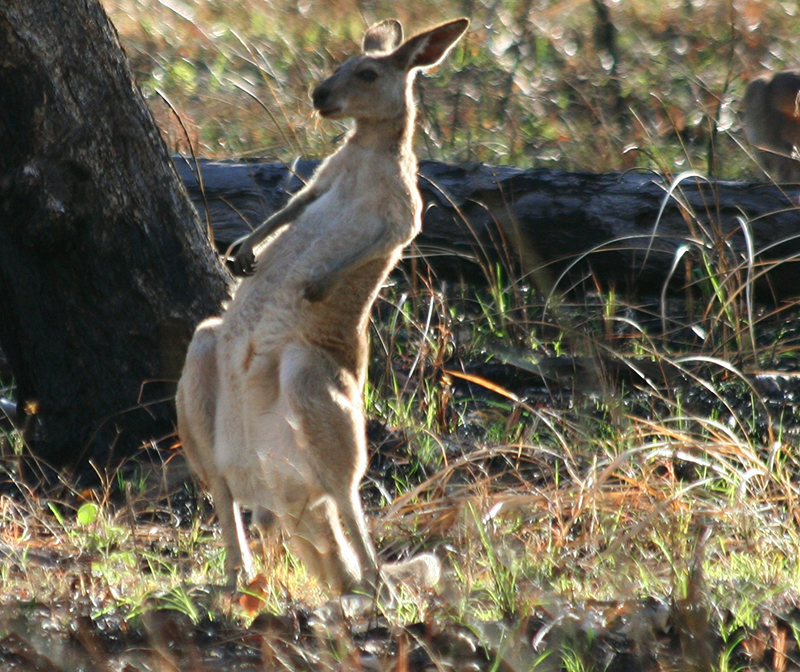 As the bush awakened for a new day and the sun gently warmed the air, we walked half a mile to a clearing for a bush breakfast laid out around a camp fire. Kangaroos were all around, feeding before the heat of the day drove them to rest in shade, green and red parrots ate berries from the scrub bushes and fat Kookaburras watched us from trees waiting for the chance to steal breakfast from the unwary. In the blink of an eye, one would jet down and make off with an unguarded meal. When one of the little sods narrowly missed pinching a Roo sausage from my plate, I hunkered down, guarding my breakfast, gulping it down like a man starved. We could not help having a snigger when an Italian fellow who had turned away to chat up a girl, turned back to discover that his plate was clean and his breakfast was inside one of the fat birds in a nearby tree.
As the bush awakened for a new day and the sun gently warmed the air, we walked half a mile to a clearing for a bush breakfast laid out around a camp fire. Kangaroos were all around, feeding before the heat of the day drove them to rest in shade, green and red parrots ate berries from the scrub bushes and fat Kookaburras watched us from trees waiting for the chance to steal breakfast from the unwary. In the blink of an eye, one would jet down and make off with an unguarded meal. When one of the little sods narrowly missed pinching a Roo sausage from my plate, I hunkered down, guarding my breakfast, gulping it down like a man starved. We could not help having a snigger when an Italian fellow who had turned away to chat up a girl, turned back to discover that his plate was clean and his breakfast was inside one of the fat birds in a nearby tree.
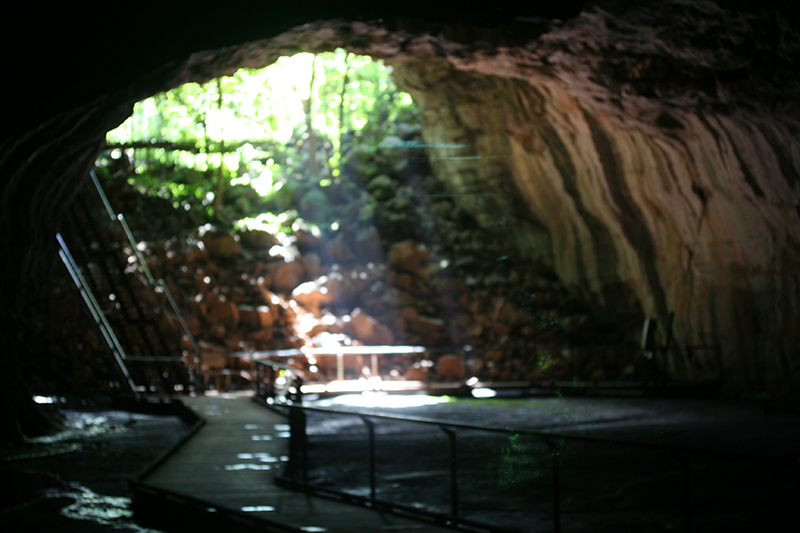 The Undara National Park contains the remains of earth’s longest flow of lava that originated from a single volcano. The Kalkani, a shield volcano, erupted 190,000 years ago and flooded a huge area with molten rock. Twenty-three cubic kilometers of lava, at a rate of 1000 cubic metres a second, flowed over the landscape to a distance of 160km in the north west. Giant lava tubes were created up to 30 metres in diameter and these are now home to millions of bats and can be walked and enjoyed by everyone. Thick mud mixed with a generous amount of bat poo lines the floor to a depth of several metres but, I’m pleased to say, the paths were generally boarded, although some are under water requiring rolled up trousers and a shot of tetanus.
The Undara National Park contains the remains of earth’s longest flow of lava that originated from a single volcano. The Kalkani, a shield volcano, erupted 190,000 years ago and flooded a huge area with molten rock. Twenty-three cubic kilometers of lava, at a rate of 1000 cubic metres a second, flowed over the landscape to a distance of 160km in the north west. Giant lava tubes were created up to 30 metres in diameter and these are now home to millions of bats and can be walked and enjoyed by everyone. Thick mud mixed with a generous amount of bat poo lines the floor to a depth of several metres but, I’m pleased to say, the paths were generally boarded, although some are under water requiring rolled up trousers and a shot of tetanus.
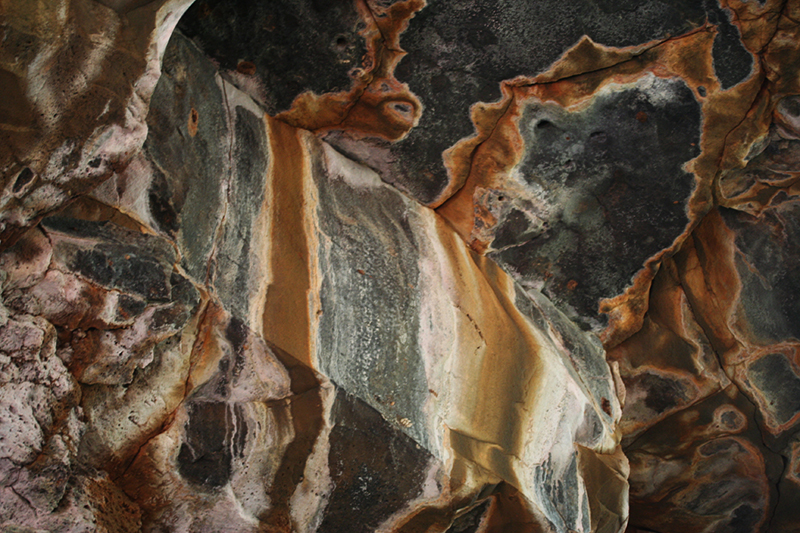 The cooled lava rock made haphazard and colourful patterns all around and above us and, in the absence of limestone, are in the same state thousands of years after becoming solid. In a few places, the roof had collapsed and the scrub flora had seized the chance to use the rich mud to grow trees and creepers that rose high above us.
The cooled lava rock made haphazard and colourful patterns all around and above us and, in the absence of limestone, are in the same state thousands of years after becoming solid. In a few places, the roof had collapsed and the scrub flora had seized the chance to use the rich mud to grow trees and creepers that rose high above us.
The landscape all around the tubes was pure outback; low trees, thick wiry grass, red soil and hot sun. Every now and then a rocky granite mound punctuated the seemingly flat ground and animals and reptiles (snakes mostly) appeared and disappeared constantly. What a contrast to the rainforest of Daintree. The areas are close enough to be neighbours yet could hardly be more different yet both are fascinating and a joy to visit.
Less joysome was our return journey to Cairns. Back into the rain again that refused to give up. Cairns suffered 3 cm of rain in two days; half the annual wet season precipitation. Mud slides closed the railways, rivers burst their banks, Daintree became cut off and any open boat in Cairns harbor sank. There was no option left to us but to go for a dive on the Great Barrier Reef; at least we would be wet intentionally.
We had dived on the reef some years before and had been disappointed, probably because our expectations had been too high so it deserved another chance. The weather was against us; rain squalls that obliterated the view and winds roughing up the sea to sickness level 7. As a result, the visibility under water was reduced to about 5 metres and the coral was grey rather than full of life and colour. Most of the fish had gone on their holidays too and the diving was, once again, disappointing in terms of marine life but it was, nonetheless, fun to float about under the ocean and infinitely preferable to spending a wet, miserable day on land.
When we were back on land, drinking a beer and watching the rainwater cascade off the corrugated roof of the terrace of a marine-side bar, we felt that Cairns is best suited to the ‘younger traveler’ who would enjoy drinking late in sweaty bars and clubs. If the sun was out, he or she would spend the day asleep on the beach and, if it were raining, he/she would spend the day asleep in bed. It was time to move on and try to find some dry, sunny weather.

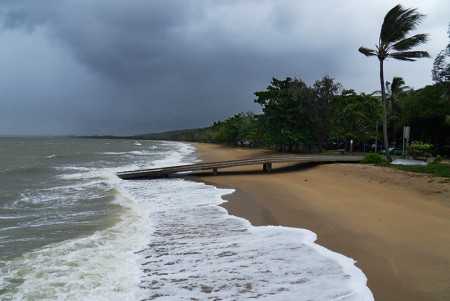
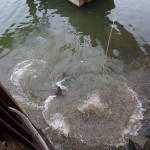
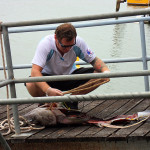
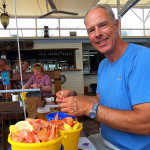
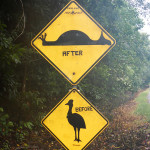
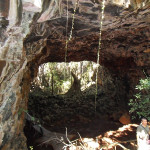
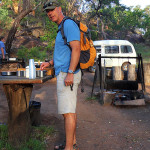
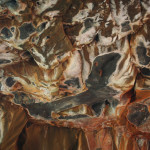
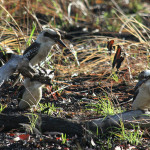
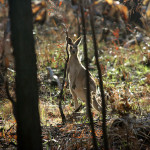
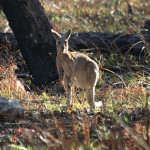
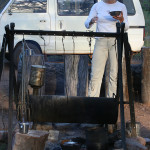
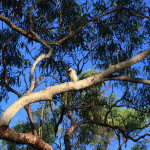
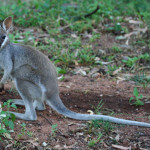
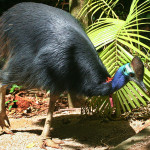
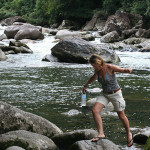
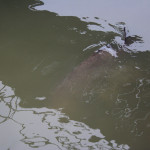
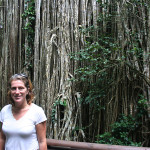
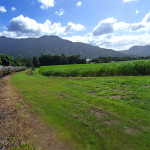
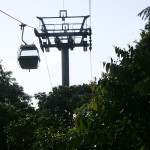
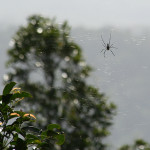
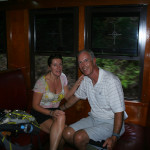
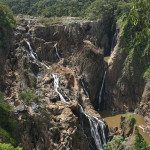
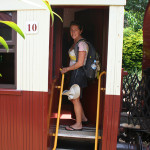
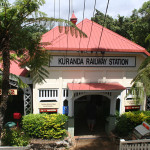
No comments yet.